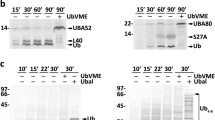Abstract
Ubiquitln-mediated proteolysis isamajor pathway for selective protein degradation in eukaryotic cells. This pathway involves the processive covalent attachment of ubiquitin to proteolytic substrates and their subsequent degradation by a specific ATP-dependent protease complex. We have cloned the genes and characterized the function of seven ubiquitin-conjugating enzymes (UBCs) from the yeast Saccharomyces cerevisiae. From this collection, UBC1, UBC4 and UBC5 enzymes were found to mediate degradation of short-lived and abnormal proteins. These enzymes have overlap** functions and constitute a UBC subfamily essential for growth. UBC1 is specifically required at early stages of growth after germination of spores. UBC4 and UBC5 enzymes are heat shock proteins and essential components of the eukaryotic stress response: mutants lacking both UBC4 and UBC5 are unable to grow at elevated temperatures or in the presence of an amino acid analog, constitutively express major heat shock proteins and are constitutively hermotolerant to a severe and acute heat shock.
Access this chapter
Tax calculation will be finalised at checkout
Purchases are for personal use only
Preview
Unable to display preview. Download preview PDF.
Similar content being viewed by others
References
Ball, E, Karlik, CC, Beall, CJ, Saville, DL, Sparrow, JC, Bullard, B and Fyrberg, EA, (1987) Arthrin, a myofibrillar protein of insect flight muscle, is an actin-ubiquitin conjugate. Cell, 51: 221–228.
Chau, V, Tobias, JW, Baenmair, A, Marriott, D, Ecker, DJ, Gonda, DK and Varshavsky, A, (1989) Amultiubiquitin chain is confined to specific lysine in a targeted short-lived protein. Science, 243: 1576–1583.
Ciechanover, A, Finley, D and Varshavsky, A, (1984) Ubiquitin dependence of selective protein degradation demonstrated in the mammalian cell cycle mutant ts85. Cell, 37: 57–66.
Dunigan, DD, Dietzgen, RG, Schoelz, JE and Zaitlin, M, (1988) Tobacco mosaic virus particles contain ubiquitinated coat protein subunits. Virology, 165: 310–312.
Finley, D and Varshavsky, A, (1985) The ubiquitin system: functions and mechanisms. Trends Biochem. Sci., 10: 343–346.
Finley, D, Ciechanover, A and Varshavsky, A, (1984) Thermolability of ubiquitin-aetivating enzyme from the mammalian cell cycle mutant ts85. Cell, 37: 43–55.
Goebl, MG, Yochem, J, Jentsch, S, McGrath, JP, Varshavsky, A and Byers, B, (1988) Hie yeast cell cycle gene CDC34 encodes a ubiquitin-conjugating enzyme. Science, 241: 1331–1335.
Hershko, A, (1988) Ubiquitin-mediated protein degradation. J. Biol. Chem., 263: 15237–15240.
Jentsch, S, McGrath, JP and Varshavsky, A, (1987) Hie yeast DNA repair gene RAD6 encodes a ubiquitin-conjugating enzyme. Nature, 329: 131–134.
Jentsch, S, Seufert, W Sommer,T and Reins,H-A, (1990) Ubiquitin-conjugating enzymes:novel regulations of eukaryotic cells. Trends Biochem. Sci.,15:195–198.
Leung,DW,Spencer,SA,Cachianes,G, Hammonds,RG,Collins,C,Menzel,WJ,Barnard,R,Waters,WJ and Wood,WI,(1987)Growth hormone receptor and serum binding protein:purification,cloning and expression.Nature,330:537–543.
Matthews,W,Tanaka,K,Driscoll,J. Inchihara,A and Goldberg,AL(1989)Involvemnet of the proteasome in degrative process in mammalian cells. Proc. Natl. Acad. Sci. USA,86:2597–2601.
Seufert, W and Jentsch, S, (1990) Ubiquitin-conjugating enzymes UBC4 and UBC5 mediate selective degradation of short-lived and abnormal proteins. EMBO J., 9: 543–550.
Seufert, W, McGrath, JP, and Jentsch, S, (1990) UBC1 encodes a novel member of an essential subfamily of yeast ubiquitin-conjugating enzymes involved in protein degradation. EMBO J., 9: 4535–4541.
Siegelman, M, Bond, MW, Gallatin, WM, St. John, T, Smith, HT, Fried, VA and Weissman, IL, (1986) Cell surface molecule associated with lymphocyte homing is a ubiquitinated branched-chain glycoprotein. Science, 231: 823–829.
Sung, P, Prakash, S and Prakash, L, (1988) The RAD6 protein of Saccharomyces cerevisiae polyubiquitinates histones, and its acidic domain mediates this activity. Genes Dev., 2: 1476–1485.
Wilkinson, KD, Lee, K, Deshpande, S, Duerksen-Hughes, P, Boss, JM and Pohl, J, (1989) The neuron-specific protein PGP 9.5 is a ubiquitin carboxyl-terminal hydrolase. Science, 246: 670–673.
Wu, RS, Kohn, KW and Bonner, WM, (1981) Metabolism of ubiquitinated histones. J. Biol. Chem., 256: 5916–5920.
Yarden, Y, Eseobedo, JA, Kuang, WJ, Yang-Feng, TL, Daniel, TO, Tremble, PM, Chen, EY, Ando, ME, Harkins, RN, Francke, U, Fried, VA, Ullrich, A and Williams, LT, (1986) Structure of the receptor for platelet- derived growth factor helps define a family of closely related growth factor receptors. Nature, 323: 226–232.
Author information
Authors and Affiliations
Editor information
Editors and Affiliations
Rights and permissions
Copyright information
© 1991 Springer-Verlag Berlin Heidelberg
About this paper
Cite this paper
Jentsch, S., Seufert, W., Jungmann, J., Klingner, B. (1991). Ubiquitin-Conjugating Enzymes Mediate Essential Functions of the Stress Response. In: Maresca, B., Lindquist, S. (eds) Heat Shock. Springer, Berlin, Heidelberg. https://doi.org/10.1007/978-3-642-76679-4_9
Download citation
DOI: https://doi.org/10.1007/978-3-642-76679-4_9
Publisher Name: Springer, Berlin, Heidelberg
Print ISBN: 978-3-642-76681-7
Online ISBN: 978-3-642-76679-4
eBook Packages: Springer Book Archive




